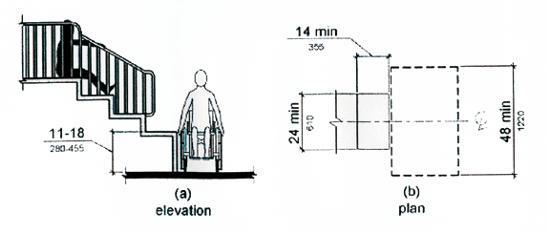Play Equipment Transfer System and ADA Accessibility
Some information below is provided by the US Access Board.
Accessible play areas that include elevated play components must provide access in accordance with Americans with Disabilities Act (ADA) Standards. This can be with a ramp or an accessible transfer system. This article will discuss a transfer system for play areas.
Play areas with less than 20 elevated play components are not required to have a ramp, so a transfer system will suffice. Play areas with 20 or more elevated play components must have a ramp, but they can also have a transfer system.
Play Area Transfer System
The photo on the right is an example of a play area transfer system. 2010 ADA Standard 1008.3, Transfer Systems, states, "Where transfer systems are provided to connect to elevated play components, transfer systems shall comply with [Standard] 1008.3." Transfer systems include transfer platforms, supports, steps, and a clear space.
The first component of a transfer system is the transfer platform. A transfer platform is a platform or landing that an individual who uses a wheelchair or mobility device can use to lift or transfer onto the play structure and leave the wheelchair or mobility device behind at ground-level. Standard 1008.3.1, Transfer Platforms, states, "Transfer platforms shall be provided where transfer is intended from wheelchairs or other mobility aids."
Transfer platforms must have adequate size, height, transfer space, and transfer supports. The transfer platforms must have level surfaces 14 inches deep minimum and 24 inches wide minimum. The height of transfer platforms must be 11 inches minimum and 18 inches maximum measured to the top of the surface from the ground or floor surface. Note that the type of material used for the transfer system and the shape of the transfer system are not specified in the ADA Standards.
A clear space complying with [Standards] 305.2 and 305.3 shall be provided adjacent to the transfer platform. The 48 inch (1220 mm) long minimum dimension of the transfer space shall be centered on and parallel to the 24 inch (610 mm) long minimum side of the transfer platform. The transfer space must be mostly level. Standard 305.2 states, "Changes in level are not permitted. EXCEPTION: Slopes not steeper than 1:48 shall be permitted." The side of the transfer platform serving the transfer space shall be unobstructed. Finally, at least one means of support for transferring shall be provided. See the diagram below for a representation of these dimensions.
Transfer System Schematic Diagram
NOTE: Adding a transfer step that leads to the ground's surface, as shown in the photo above, increases access for children exiting components at the ground level.
From the transfer platform the accessible route to the elevated play equipment usually goes up a set of steps. Transfer steps must have level surfaces 14 inches (355 mm) deep minimum and 24 inches (610 mm) wide minimum, each transfer step shall be 8 inches (205 mm) high maximum, and at least one means of support for transferring shall be provided. See the graphic below for a representation of a transfer system step installation.
Transfer System Step Diagram
Notice that the steps shown above should be not more than 8 inches vertical. That is a maximum. They can be shorter. In fact, play areas intended for smaller children should provide steps at smaller height increments. This will accommodate smaller sized children who must lift or “bump” up each step. See the photo below for a representation of steps for smaller children.
Step System for Smaller Children
The supports mentioned above for the platform and steps can come in many different forms. 2010 ADA Standard Advisory 1008.3.2.3, Transfer Supports, states, "Transfer supports are required on transfer platforms and transfer steps to assist children when transferring. Some examples of supports include a rope loop, a loop type handle, a slot in the edge of a flat horizontal or vertical member, poles or bars, or D rings on the corner posts." See the photo below for a representation of transfer system supports.
Transfer System Supports
Consideration must be given to the distance between the transfer system and the elevated play components it is intended to facilitate. Designers should minimize the distance between the point where a child transfers from a wheelchair or mobility device and the elevated play destination.
Please call me at 615-752-0060 should you have any questions, or comment below.
If you observe a playground or building that is not ADA compliant and you would like to know how to proceed, please see the link at What To Do When A Building Is Not ADA Compliant or Accessible.
ADA Inspections Nationwide, LLC, offers ADA/ABA/FHA accessibility compliance inspections for buildings and facilities, as applicable to the different laws, and expert witness services with respect to ADA/ABA/FHA laws for building owners, tenants and managers. Also, ADAIN offers consulting for home modifications as a CAPS consultant for people wishing to age in place in their homes. For a complete list of services please see ADAIN Services.
Thank you.
Article Revised September 2021






